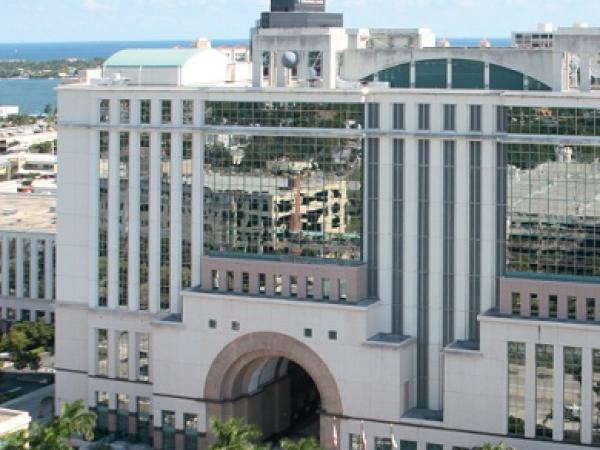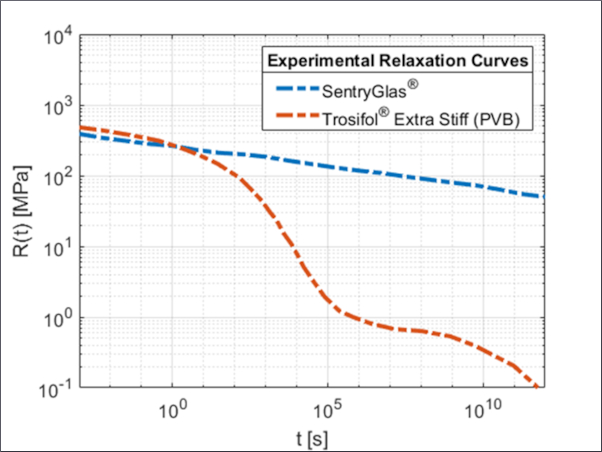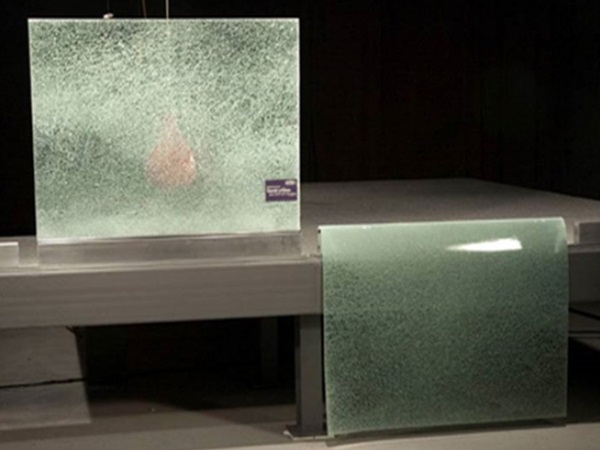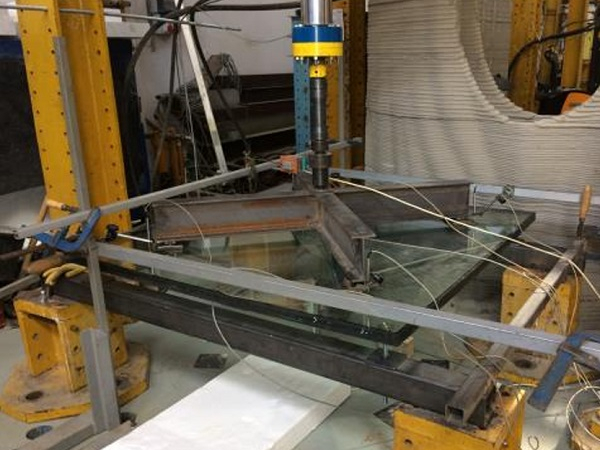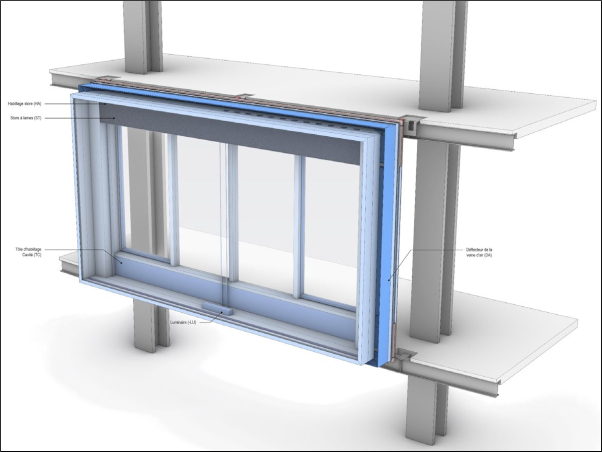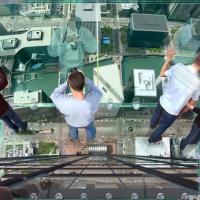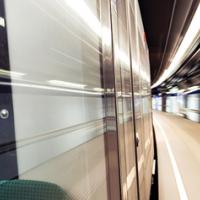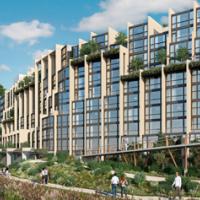Built in the mid 90s, the imposing 12-storey building – which houses a wide variety of offices, administration centers, chambers and courts – had to be brought up to current building codes following the devastating effects of Hurricane Andrew, one of only three category five hurricanes to hit the United States in the 20th Century.
The building already had a significant façade infrastructure as part of the original build, but after Hurricane Andrew in 1992 building codes in South Florida were significantly revised; demanding even greater protection from high speed winds and the effects of flying debris.
.jpg)
Photo: Harmon
Architect Mark S. Beatty AIA, LEED A.P., who at the time worked for MPA architects, explains the reasoning behind the renovation: "The building was built just before Hurricane Andrew with insulating glazing in the façade. Following Andrew in 1992, Frances and Jannie in 2004 and Wilma in 2005, FEMA money became available and, coupled to a matching grant, the finances were in place to make it not only hurricane hardened but also to solve a water infiltration issue it was facing.
"We were extremely fortunate in that after some initial meetings spent poring over the original architect's drawings and running preliminary engineering calculations, we discovered that the existing façade frames had the potential to meet the revised codes – all we had to do was replace the glass panels," Beatty explains. "Based on the initial findings, we went forward and contracted with the Weitz company to reconstruct and test a modified mock up of the building's glazing and framing facade in a hurricane testing lab. It successfully passed the tests – including the county's high-velocity wind zone requirements – with only minor modifications to the beading. We then went forward and prepared a design based on new large-missile-impact glass panels comprising Viracon’s VP reflective coating on the #2 surface of the insulating glass unit and 14.29 mm (9/16in) laminated with 2.28 mm (90-mil) SentryGlas® interlayer on the inboard.
"The original glass façade panels were not designed to be impact resistant," he elaborates, "they were insulated doublepaned glass, so we needed a tougher replacement. As well as the impact performance however, we were also concerned that we were going to change environmental dynamics of the façade, which had originally been designed for a certain solar performance. The new system had to offer the same or better performance, or the building might not be able to cool itself. During the testing phase we ran a number of energy models to ensure that we could address the environmental issues. As it turns out, the new panels with the SentryGlas® interlayer actually offered better thermal performance after the application of a film coating that was as close to the original that we could find. The new coating, which, like the old coating, is reflective so you can't see inside the offices on outside walls, also contributed to the better thermal performance and retained the visual security for the occupants inside.
"I know that SentryGlas® is stronger than PVB," Beatty concludes, "and this gives us a lot of freedom as architects when it comes to structural design. In addition, one of the big issues we have from an aesthetic standpoint is clouding and delamination; something else that SentryGlas® resists far better than other industry alternatives."
The glass fabricator for the courthouse, Viracon, undertakes jobs like this and deploys SentryGlas® in a number of applications. According to Kevin Anez, director of marketing at Viracon: "We have the capability to design and develop glass solutions with SentryGlas® interlayers and ultimately the decision to use SentryGlas® is determined by how well the product meets both aesthetic and performance requirements.
"In this project Harmon Inc. validated the specified interlayer," he adds, "by using a test laboratory to conduct a large-missile test; and Harmon's subsequent Notices of Acceptance (NOA) determined that the SentryGlas® interlayer would meet the performance requirements as specified by the architect. Building codes continue to become more stringent. Therefore, we continue to focus on developing new products that meet the requirements of our customers both from an aesthetic and a performance perspective.
"We have a good working relationship with DuPont," he continues, "and we collaborate on projects when necessary. The SentryGlas® interlayer has good structural integrity and performs well in a large-missile test, so in certain applications customers are specifying SentryGlas® for buildings that could be exposed to higher-wind-load conditions or higher threat levels such as flying debris from a hurricane."
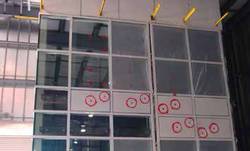
The SentryGlas® interlayer was validated using a test laboratory to conduct a large-missile test. The subsequent Notices of Acceptance (NOA) determined that the SentryGlas®interlayer would meet the performance requirements as specified by the architect.
Photo: Viracron
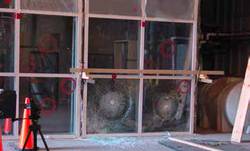
Photo: Viracron
The SentryGlas® interlayer was validated using a test laboratory to conduct a large-missile test. The subsequent Notices of Acceptance (NOA) determined that the SentryGlas® interlayer would meet the performance requirements as specified by the architect.
Trevor Barrett, General Manager, Harmon, Inc. South Florida, who installed the façade, adds his thoughts: "The only modifications we needed to make were for the glazing adapters, in order to get more 'bite' on the glass, we didn't have to undertake any reconfiguration of the vertical mullion supports. "At the end of the day," he continues, "we knew that by using DuPont™ SentryGlas® we had installed a premium product in this application, one that will perform for many years; it was completely dominant in the testing and there were certainly no after thoughts about not using it.
"SentryGlas® is one of the strongest interlayers available," Barrett concludes, "and coupled to its resistance to water ingress and delamination it is certainly an ideal product for demanding exterior applications. I deal with DuPont on weekly basis, discussing code changes and performance criteria and what the company really delivers on top of its industry leading products is real in-depth knowledge and support."
Lighter façade panels enable more subtle supporting structures
For decades, interlayers made of polyvinyl butyral (PVB) have been the industry standard when producing laminated safety glass. Architects are well aware of the possibilities and limitations of such glass when used extensively in façade engineering, for roofing and window panels. In contrast, SentryGlas® enables an entirely new approach because the interlayer is over 100 times stiffer and five times stronger than PVB. As a consequence, there is an almost perfect transmission of load between two laminated sheets of glass, even at high temperatures, leading to the excellent flexural behavior of the glass when under load – also under direct sunlight in high summer. Accordingly, laminates with SentryGlas® show less than half the rate of deflection when compared to laminates with PVB, when under the same load, and thus almost the same behavior as monolithic glass of the same thickness.
.jpg)
Main benefits of SentryGlas®:
- Safety: In the event of breakage, glass fragments remain firmly bonded to the interlayer, reducing the chance for injury.
- Security: SentryGlas® can be used in glazing that withstands bullets, hurricane-force winds and even bomb blasts.
- Solar energy control: SentryGlas® can be used with coated low-E glass for improved energy efficiency. It can also help engineer more effective thermally insulated glass, and glass with better controlled (or allowed) transmittance of V radiation.
- Durability: SentryGlas® is extremely durable and resistant to clouding, even after years of exposure.
- Design Versatility: SentryGlas® can be used in glass manufactured flat or curved, including annealed, toughened, heat-strengthened, spandrel, wired, patterned and color-tinted glass.
REGIONAL CONTACT CENTERS FOR DUPONT™ SENTRYGLAS®
DuPont Glass Laminating Solutions
Wilmington, Delaware U.S.A.
Telephone +1 302 774 1161
Toll-free (USA) 800 438 7225
Fax +1 302 892 7390
DuPont do Brasil, S.A.
Barueri, Sao Paulo Brasil
Telephone +55 11 4166 8542
Fax +55 11 4166 8720
DuPont China Holding Co., Ltd.
Pudong New District, Shanghai
Telephone +86 21 3862 2888
Fax +86 21 3862 2889
DuPont de Nemours Int’l. S.A.
Geneva, Switzerland
Telephone +41 22 717 51 11
Fax +41 22 717 55 00
.jpg)

